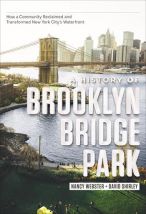A History of Brooklyn Bridge Park: How a Community Reclaimed and Transformed New York City’s Waterfront

A History of Brooklyn Bridge Park is co-authored by the head of the Brooklyn Bridge Park Conservancy (formerly the Brooklyn Bridge Park Coalition) and a freelance journalist. Unsurprisingly, then, the tone is narrative rather than academic, with abundant interview segments with people involved in the process, and plenty of photos showing the transformation of this space.
The Brooklyn port fell into disuse around the mid-1970s, and the Port Authority decided to dispose of the piers in 1983. The Port Authority was required to consult local leaders, and thus contacted the Brooklyn Heights Association. For this association and the Waterfront Committee it formed, when it came to deciding how to best influence use of the 87-acre property, “The overriding objective was to find the most beneficial use of the property for the community residents and the rest of the city” (page 29).
The book traces the long process of negotiation over this land. For instance, in 1985 the Port Authority and its local government partners announced intentions for private development – to the dismay of the Brooklyn residents who were concerned about protecting their views over their waterfront. To commission an alternative planning study to the one produced by the government-hired consultancy, the Waterfront Committee morphed into the Piers Committee, which included outspoken novelist Norman Mailer. The resident-commissioned study proposed converting the entire waterfront into a park.
Pressures to commercially develop the piers were eased when the New York governor instructed the Port Authority to move away from a private housing-focused model. But the Brooklyn Bridge Park Conservancy also had to make the case that the development of the park would benefit more than a narrow section of the New York City elite. This involved integrating media and public relations considerations into its advocacy, and working across various levels of government (borough, city, state). “The difficult and time-consuming process of developing and building public consensus around the guiding principle for the park would…become one of [the Brooklyn Bridge Park Coalition’s] signature contributions to the park movement” (page 76). Other challenges included battles over civil society group leadership, as well as fiscal issues in 2008 due to the larger financial crisis.
Finally, however, the park opened in 2010, after more than two decades of contestation. The book acknowledges the contributions of a wide variety of people, but focuses on the local residents who advocated for the creation of the park. Some of the advocates for the park think that larger lessons can be drawn from this case, where “Brooklyn Bridge Park not only is an important achievement for the residents of Brooklyn but also represents the beginning of a citywide and nationwide movement to reclaim urban waterfronts for the public” (page 202).
Further reading:
Baud, Isa and Navtej Nainan (2008), “ “Negotiated spaces” for representation in Mumbai: ward committees, advanced locality management and the politics of middle-class activism”, Environment and Urbanization Vol 20, No 2, pages 483–499, available at http://journals.sagepub.com/doi/abs/10.1177/0956247808096124.
Hand, Scott M and Otis Pratt Pearsall (2014), “The Origins of Brooklyn Bridge Park, 1986-1988”, Brooklyn Historical Society, available at https://brooklynhistory.org/library/wp/the-origins-of-brooklyn-bridge-park-1986-1988/.
Kitha, Justus and Anna Lyth (2011), “Urban wildscapes and green spaces in Mombasa and their potential contribution to climate change adaptation and mitigation”, Environment and Urbanization Vol 23, No 1, pages 251–265, available at http://journals.sagepub.com/doi/abs/10.1177/0956247810396054.
Book note prepared by Christine Ro
Search the Book notes database
Our Book notes database contains details and summaries of all the publications included in Book notes since 1993 - with details on how to obtain/download.
Use the search form above, or visit the Book notes landing page for more options and latest content.
For a searchable database for papers in Environment and Urbanization, go to http://eau.sagepub.com/

